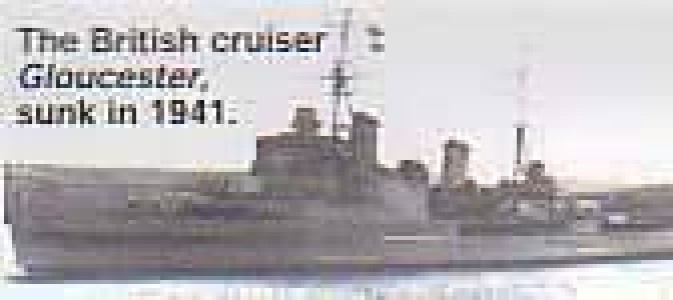The British cruiser Gloucester was sunk near Kythera
As James Prineas provided the photograph of the plaque on a house in Kapsali, it may be appropriate to re-submit the history behind the plaque.
Kythera is a small island just south of Neapolis at the southern tip of Greece. It is also about 50 miles northwest of Cape Spatha in northwest Crete. In the battle for Crete in 1941, the Southampton-class cruiser HMS Gloucester was sunk on the 22nd of May about 15 miles from Kythera, which was already occupied by the Germans. Seven hundred and twenty-three lives were lost, but 78 were saved by small craft manned by Germans, searching for survivors from their own ships. (One report in Britain says that 722 lives were lost and there were 85 survivors).
They were taken to Kapsali where they were placed in a house on the beachfront. They were cold and exhausted, and encrusted in salt and black oil. Apart from the clothes they were wearing they had nothing. Food on the island was short and the islanders went in fear of their lives, but from the horror of one of the worst battles of World War II, comes a story of selfless courage. A number of Kytherians witnessed the sinking of Gloucester including 15 years old Nikos Sotirhos and his friends Yiannis Margetis and others.Despite the curfew and the danger from the German guns, they planned to help the British captives, by collecting eggs, milk, bread, cheese or whatever food from their families and friends.One of the boys spoke a little German and he set out to distract the German guards at the front of the house while the other two came down through the trees behind the house, climbed into the back courtyard and passed the food through a window to the prisoners. For several days the boys kept up their search for food and their dangerous mission of feeding the British captives. When the Germans eased their guard, people from all over the island contributed food, clothes and shoes for the boys to take to the prisoners. By then a number of other boys got involved in collecting food including my late brother Christos and myself. After 10 days the Germans took the men away to spend the rest of the war as prisoners on the mainland. Two of them died in captivity. But for the courage and initiative of a small group of boys, more men might have been lost during those days on Kythera.
In 1984 one of the survivors, John Stevens, formed the "Fighting G Club" to enable survivors, their families and friends to hold annual reunions. The Club attracted its largest attendance in May 1999, after the televising of the documentary "HMS Gloucester - The Untold Story" based on the book by Ken Otter. It was decided that a party of club members would visit Kythera and that was arranged by Betty Birkby, daughter of Gloucester's Captain Rowley, who was the last to leave his ship, but did not survive. The trip was a time to pay tribute to the courage and warmth of generosity to the people of Kythera for the help they had given to the survivors of HMS Gloucester. On a brilliant cloudless day, the party was taken out in the caique "Alexandros" to the site of the war grave. There, a memorial service was held and flowers were scattered on the sea. Prayers, led by the Reverend Alex Mills were said.
"Prayers for peace and understanding between peoples of all nations, in the hope that the hand of friendship would always be extended to ordinary people to their neighbours in other countries. The courage of the people of Kythera in the face of adversity has not been forgotten. The gratitude of the families of the British naval men who landed on the Kytherian shores in 1941, may be belated,but it is sincerely felt. God bless them all."
In 2001 a party of the Fighting G club that included six survivors of the Gloucester sinking, visited Kythera to present a plaque in recognition of the 60th anniversary of the sinking. The plaque was delivered on the type-23 frigate HMS Northumberland and then attached to the outside of the house where the captives had been held. This plaque was unveiled by the British defence attache to Greece, Commodore John Milns, RN. During the three day event, Northumberland at anchor in Kapsali, provided a guard of honour for a parade of veterans, their families and friends and a memorial service was arranged aboard ship.The party then went out to the site of the sinking of Gloucester-which is a dedicated war grave, to allow wreaths and flowers to be laid on the water.
A lot of information was provided by the 2000 Summer Edition "Kythera", also by my good friend Malcolm Wright ex British Captain and BBC reporter. A lot of information was also found on the internet, but I witnessed myself the survivors when they were brought in Kapsali and as a nine year old then, this will be remembered forever.
In an entry on this website under the heading of "Island Photography - Gravestones" a photograph of the plaque that the British attached to the house has been contributed by Peter Tzannes, provided by Helen Magiros.
